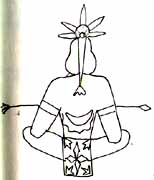American Sabbatical 101: 4/24/97
Tahlequah
4/24.. Talequah
Peggy doesn’t give up easily. She had her heart set on finding the end of the Trail of Tears,
so we set off from Salisaw . Not before making a ritual stop,
however. She’d visited a Cherokee Nation gift shop on our last
passage through, and had found it full of local beadwork. We’d
spent the night across the road from it, so...
Then on to Tahlequah, the Cherokee capitol. But which sites to
visit? To peruse the guides there were a dozen likely spots where
we might lay hands on the spirit of the place. We’d found history
in Oklahoma an elusive prey, however. Either every stone was historic,
or pieces of an old cabin were enshrined by mom and pop.
The country is a joy, though, so we meandered around Northeastern
Oklahoma. More rolling hills than mountains here, and the trees
less towering. You can sense the prairie province seeping in.
Lots of small scale agriculture here. Beef and ratites. Hard to
think of the Cherokee as ostrich breeders. Then again, those plumes
on the head dresses in the old paintings...
Our first stop was at Gore, where a council house and court house
had been preserved. Another family operation, with the flagstone
dwelling and outbuildings in a compound with the historic structures.
Maybe I should renovate my attitude. Here were all the signs of
seasonal pluralism, that mixed subsistence economy we’d been a
part of in the maritimes, and I remember how healthy it was to
change jobs through the seasons. Incorporating a bit of historic
preservation in the mix seems a shrew addition. Turns out this
is actually a Cherokee Nation site, and the caretaker produces
the local paper as well, but that doesn’t devalue my premise.
Why not enshrine and museumize part of your house, and put down
your tools when the tourists arrive? Where does local history
start and finish? Is there a different attitude toward history
here?
The map wasn’t clear about the route from Gore to Tahlequah, so
we Owled crosslots by compass. You get a different sense of environment
roaming the tertiaries. Winding up and down the backroads. Pulling
over to let the locals flash past. We were circumnavigating the
Tenkiller Reservoir, and there were the requisite boats on trailers
in the dooryards. What there weren’t were churches at ever crossroads.
A few “Ritual Centers”, but no Burma Shave scriptures exhorting
our holiness, or warning against our deviltry. I’d actually grown
fond of the fervid sanctimony, and looked forward to the next
obscure chapter and verse. “What shall I do with this Jesus they
call Christ?” But here there was only an occasional sign in Cherokee
script. Of course, they might be Bible quotes, too.
Peggy had weaned the list to two excitements in Tahlequah. The
Cherokee Heritage Center, where there is a tribal museum and a
preserved village, and the Murrell House, the only house to survive
the devastations of the Civil War. Well, the Heritage Center was
a bust. The Museum is closed. We looked in the windows, and it
looked a bit thin, in any case. An exhibit under construction
honoring a tribal elder was a display board of platitudes without
any grist. The village was a collection of turn-of-the-century
buildings from all over Oklahoma brought together in a twisted
grove of 50 foot hardwoods, just starting to leaf out. It was
strange coming into this hunkerdown grove out of the open sweep
of rolling country, and the village had absolutely no charge.
I still wonder what sparks the magic in these sites, or doesn’t.
I sketched the one building that caught my fancy, a small house
which had a hint of that verticality we’d admired in the Chucalissa
thatched houses and in the Cherokee buildings at New Echota. An
echo of a traditional esthetic? Perhaps.
(Memo #98)
Apr 24 The End of the Trail of Tears
WHO? Cherokee tribe
WHAT? Cherokee Courthouse and Council House, also Cherokee Heritage
Center
WHEN? after Cherokee Removal of 1830’s from southeastern USA
WHERE? eastern Oklahoma (Gore and Tahlequah)
HOW? historic sites and culture center to celebrate Cherokee history
TOPICS: Cherokee tribe, Trail of Tears, Native American history
QUESTIONS: What happened at the end of the Trail of Tears? |
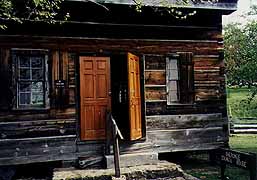
Council House
|
Every bit of history you begin to investigate gets more and more
complex. There were really MANY trails of tears. The Cherokee
moved west in a number of stages at different times. There were
groups that migrated early and voluntarily to Arkansas (Sequoyah
among them) even before 1800 and established themselves there.
They were called the Western Cherokee (or Old Settlers) and later
in 1828-9 were removed from Arkansas to Indian Territory (Oklahoma).
Even the famous Trail of Tears that was (the forced removal of
the eastern Cherokee in 1838-39) occurred over several years and
used several routes and had stops and involved a number of migrating
groups. It is hard to get the whole picture.
I've wanted to tour the Indian areas of eastern Oklahoma for years,
to see what life was like AFTER the Trail of Tears. Our recent
travels in Georgia to the prehistoric mound sites and then to
the pre-Removal Cherokee sites made me even more eager, to see
the end of the trails. At New Echota, Georgia, we saw the incredible
government buildings the Cherokee had constructed for their new
democracy, the Council building, the Supreme Court, also the newspaper
office - all clapboard structures with steep pitched roofs, many
glass windows, well crafted furniture. We saw grand Cherokee mansions
(Vann house, Ridge house), and smaller farm homesteads. Would
things be physically the same in Oklahoma?
Guidebooks listed many Native American sites and things to see
in Oklahoma - remember that the Cherokee are only one of the tribes
"removed". There were also tribal areas for Choctaw, Chickasaws,
Creeks, Seminole and others. There are local museums and town
museums and private (mom and pop) museums and mission sites and
statues. We toured the prehistoric mound site at Spiro to see
the western edge of the Mississippian prehistoric culture.
With limited time we decided to go to Gore to see the Cherokee
Council buildings, then to the Cherokee Heritage Center at Tahlequah
(the major town of the Cherokee area) to see a reconstructed ancient
Cherokee village, a 1900 village, the Cherokee tribal museum.
The Gore site is on a hill right by the highway about thirty miles
southwest of Tahlequah. Named after the chief who lead the first
group west, it is called TAHLONTEESKEE (the Council ground of
the western Cherokee). The Western Cherokee reestablished their
tribal government at Gore and this was the Cherokee western capital
from 1829-39. Chief Tahlonteeskee was succeeded by John Jolly,
a friend of Sam Houston, who visited the Gore area. Houston had
run away from home to live with the Cherokee as a boy in Tennessee
and married one of John Jolly's daughters.
In 1839 the eastern Cherokee who survived the the Trail of Tears
arrived in Oklahoma. There was a struggle over government between
the eastern and western (Old Settler) groups. The Eastern Cherokee
under John Ross (who remained as Cherokee leader through the forced
Trail of Tears and into the 1860's) got control of Cherokee government
and moved the government to Tahlequah in 1843 where it still is
based. The factions came together in 1846 when the two leaders
(John Ross and Stand Watie) met to shake hands and ushered in
what is called the "Golden Age". This ended, tragically in the
Civil War. Cherokee served on both sides of the conflict and the
US government later used the tribe's "treason" as justification
for taking more land. The Murrell home in Tahlequah is the only
Cherokee house there to survive the Civil War.
|
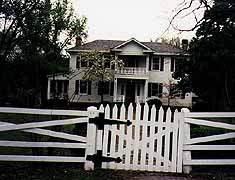
Murrell House
|
At Gore, the three buildings are crowded into a small fenced area
between a rural road and the highway with a modern ranch house
(for the site supervisor) and a small gift shop abutting them.
The buildings are made of rough boards with a few windows (not
the grander clapboard construction of New Echota). Each has a
stone stoop and fireplace for heat. There is an original one and
a half story frontier home built in 1843 that was moved to the
site. The other two (the Court building and Council House) are
accurate replicas. Each is about thirty by forty feet square.
There are good benches and tables in each. Each has exhibit cases
on a variety of subjects - cases of stone arrowheads, old picture
from Cherokee history, maps of Indian Territory. There was a reproduction
of parts of the Cherokee "Laws of Old Settlers" (monogamy, women's
legal rights, conditions under which "accidental" death was forgiven,
establishment of Cherokee police). There was little text material
(brochures or labels) to make the buildings come alive. It seemed
a random collection of tribal memorabilia. Maybe this is why the
site had so little "charge" for me.

Cherokee House
We went on to Tahlequah through hill country, following the edge
of a series lakes. This areas has been built up as fishing resorts
and we saw many roadside signs for cabins and boats, jet skis
and bait. Also many planned communities.
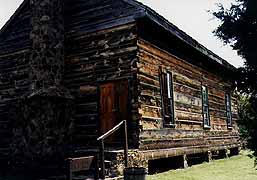
Cherokee Court House
|
At Tahlequah we easily found the signs in to the heritage center
and had a real disappointment. The museum (in a lovely modern
stone and glass center) was closed as was the recreation of the
prehistoric village!! We could tour the 1900's "village", a collection
of historic buildings that have been moved to the site and gave
me the feel of a movie set (all smartly painted). There was a
one-room school, a church, a store, several houses from around
1900 in a rather crowded fenced site.
|
Near the Heritage center is the imposing white Murrell House,
the only Cherokee home in Tahlequah to survive the Civil war.
It is grand in the manner of the eastern Cherokee plantation houses
like Ridge home (The Chieftains) of Georgia. The homesteads and
houses shows how affluent and cultured the Cherokee were as agricultural
settlers, even on the frontier in Oklahoma. The present day Cherokee
government is housed in a large complex of modern brick buildings
on the edge of Tahlequah and were very busy on the day we visited.
Tahlequah is a large modern town with all the usual business you
find on a typical American strip - fast food and malls. The Cherokee
sites in Oklahoma did not equal those in Georgia for me, but I
find the rolling hills and rich woods of Oklahoma very beautiful.
Far from being plunked in a barren wilderness of grass (as I had
once thought), the Cherokee found a lovely lands at the end of
the hideous Trail of Tears (though it may never have equaled their
Georgia and the Carolina homes for them).
4/24.. cont.
Peggy had had enough. We photographed the Murrell House, now a
private residence, on our way out of town. We headed for Tulsa
and the Gilcrease Museum of Art.
Coming down out of the hills by stages. We’d cross expanses of
flatlands with widening vistas, then entangle in convolutions
again. We’d left the great woodlands behind and the trees were
more hunched and thickety, showing twisted habits, or leaning
away from prevailing winds. Lots of untilled pasturage here. Except
for the barbed wire, this could be the broken buffalo grounds
or the cattledrive ranges of old. Tahlequah calls itself the “Nursery
Center of America”, and long plastic greenhouses and rows of nursery
plantings and pot shrubs patterned the landscape here and there.
We’re back in early Spring again, with only hints of green in
the fields, still dominated by the somber khakis of winter straw.
And oil pumps, dipping and rising. The towns rawboned and muscular.
Very workaday places. Men in ballcaps driving pickups full of
welding rigs, flatbeds loaded with pipe. None of your squishy
politics here, I bet.
And the weather is catching up with us. Northeast gusts shoving
the Owl. The ceiling coming down. Bursts of rain. By the time
we get to Tulsa it’s coming down steady and we’re glad of an inside
visitation.
Tulsa is a full-sized burg, the first we’ve encountered since
the Big Easy. We even saw a Borders alongside the highway. And
it’s as sprawled as any suburban urge could wish. As we rolled
across the superhighwayed grid we kept looking for a highrise
downtown, and were fooled three times by miniclusters before we
spotted the tall shinys of the big brag. The Gilcrease Gallery
of American Art is another oil fortune collection perched on the
upside of town. That means high on the hills over the Arkansas
River.. above the suburban clamor.
A great collection. These privately endowed institutions have
a more laidback atmosphere. It’s all bought and paid for, we aren’t
trying to sell you anything. As usual I was knocked out by the
Remingtons, but there was a lot more here to bug your eyes. I’d
never seen a collection of Millers.. or even a mention of King.
King’s paintings were of Native Americans very early in the 19th
century, and were more interesting for their historic qualities
than for their technique. The Millers on the other hand were extremely
evocative studies of Indian faces, with none of the emphasis on
their exotica. DeVoto, in Across the Wide Missouri follows Miller’s
travels in the High West, and it was a thrill to see some of the
actual paintings.
The 20th century sculpture of Willard Stone was what grabbed me
hardest at the Gilcrease. His stylized evocation of a Native mythos
felt just right. Not mawkish or condensed to logos, simply reduced
to the essential gesture. The wood spoke through the forms, and
the human truths as well. I’d smiled at the listing of Willard
Stone’s house and personal collection in the Oklahoma State guide.
Now I was sorry we’d missed it.
The guide had also been wrong about the hours at the Gilcrease,
saying it would be open late on Thursdays. Closing call came all
too soon. Before we could soak it in, and do sketches. Out we
went onto the rainy prairie. West of Tulsa you are definitely
in the West. We logged some more miles across the Great American
Desert, and finally came to rest in Stillwater.
(Memo #99)
Apr 22 Norton Museum and the Gilcrease Museum
Who? two arts patrons, Norton and Gilcrease
What? museums of (European and) American art
When? twentieth century
Where? Shreveport, LA. and Tulsa, OK.
How? collections by wealthy men
Topics: museums, western art, Remington collectors, patrons
Questions: What is western art? Should it be judged differently
from other art? |
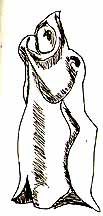
Tree Dog
(After Willard Stone)
|
The Norton Museum is a lovely yellow brick building in its own
park in Shreveport. It is amazingly low key, in fact it is so
little advertised that it was difficult to find. Almost no signs.
There is no entrance fee and no reproductions of the art in postcards,
only art books. It has about ten galleries divided by style and
medium: glass in one and firearms in another. We focused on the
western and Hudson School galleries, the Remingtons, Bierstadts,
Durands.
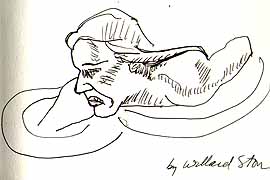
|
The Gilcrease Museum is on a lovely hill on the western edge of
Tulsa with a vista of rolling hills from its lounges, and azaleas
all around. Its collection is American, from marble busts of the
founding fathers by Houdon to works by twentieth century Native
American artists. It also has a strong collection of Hudson School
artists, especially Thomas Moran. It has some real surprises too:
a watercolor by John Singer Sargent of marching soldiers on the
western front, impressionist scenes by Remington, sculpture by
twentieth century Oklahoma Native Americans. |
We toured both museums, in spite of advancing museumities, because
of the fame of their Western collections, especially works by
Remington and Catlin.
|
My husband and I are fans of Frederick Remington. The more we
look at his work, the better it becomes. His bronze sculptures
of cowboys are well known as are his painting of cowboy scenes.
Some people scorn him as an “illustrator”. True, his pictures
often tell stories vividly. But look carefully and you’ll see
the skill and the craftsmanship in a variety of media. He did
watercolor, gouache, oil, pencil, ink, sculpture. He uses impressionist
techniques and realism. Some of his paintings verge on photorealism.
Others - like a moonlit scene of Native American women butchering
a buffalo - have the feel of a Whistler night scene in London. |
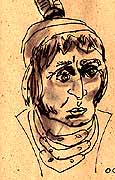
Oceola
|
When we visited the Cody Center in Wyoming last fall and saw its
gallery of Western art we pondered the whole question of art v.
illustration. The Cody gallery tackled the issue this way:
|
“This type of art has sometimes been criticized as ‘merely’ illustration,
implying a lack of creativity on the part of the artist because
he did not necessarily originate the subject matter. Yet the best
illustrators can stand on their own as works of art. These
artists use the elements of art to make strong visual statements
while following a long tradition of storytelling through painting.”
|
|
At both the Norton and Gilcrease we saw works of art by Western
artists that can stand on their own.
Remington is represented at both museums by both two and three
dimensional art. He did some quite different black and white illustrations
of the Hiawatha story. One is called the “Famine Death of Minnehaha”
and has a spectral figure looming over her bed. Another pair of
small pictures is his representation of Paleolithic man and Paleolithic
woman (a bit more brutish than today’s reconstructions). I do
really love his night paintings, he caught moonlight with a pale
green light to each scene. The Norton has Remington’s first oil
done when he was 24. It IS exciting to see a lot of work by one
artist. Remington’s Native Americans are often lyric figures that
don’t seem maudlin to me. Remington’s oils often catch people
in a moment of reflection or pause - looking at clouds or reacting
to a death. His bronze statues, on the other hand are action shots
of bucking broncos, collisions between a buffalo and a rider,
groups of galloping horsemen. They are wonderfully intertwined
and massed. None is bigger than two or three feet wide and two
feet tall. Often the whole statue is poised on a horse’s leg or
a buffalo’s rear quarters. It is amazing to see the detail of
a man being violently thrown from a horse that is caught on a
buffalo’s horns. Occasionally the proportions seem a little off
or a movement bizarre, but then how many of a us have seen a man
being violently thrown from a horse caught on a buffalo’s horns?
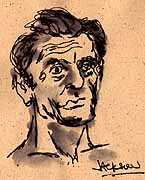
Jackson
|
The other famous western artist represented at both museums is
Charles M.
Russell. His colors are vivid and his scenes realistic. There
is a great deal of detail to take in. And he paints most lovely
skies, evening skies and dawn skies and bright sun. Yet I find
his figures often verge on caricature and I don’t react to them
as strongly as Remington’s.
|
For both men, the “West’ is rolling grassland, sandy draws and
dry lands with stark mesas. Our travels have shown us a much wider
variety of western landscape - the lovely high meadows of Wyoming
and Idaho, the steep forested slopes, the variety of woods even
in western Oklahoma and Kansas. Navajo country has pinyon forests.
The Gilcrease had federal era portraits by Peale and Sully. Two
marble busts (of George Washington and John Calhoun) that catch
the men’s power and conviction.
There are delightful oils by George Catlin, including a hilarious
one of a huge prairie dog town. An unexpected portrait was of
a Cherokee chief by Sir Joshua Reynolds (painted in London or
America?). Wonderful pictures by Alfred Jacob Miller and Charles
Bird King. |
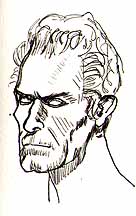
Calhoun
|
There were icons of American art at both museums, pictures that
are in every American history textbook: Penn’s Treaty with the
Indians, Walker’s scene of a cotton plantation, Remington’s Stampede,
Moran’s waterfalls, Biertadt’s Yosemite. There is a shock of recognition
before your eyes examine the works. You often find new colors.
The Hudson School paintings really are huge and the scale is extremely
effective. The viewer is drawn into the landscape. Moran’s huge
"Shoshone Falls" seems to fill the gallery with thunder and cool
spray. I found it mesmerizing.
Gilcrease was a patron of Native American artists in Oklahoma.
Three men in this century are extensively represented: Acee Be
Eagle, Woody Crumbo, Willard Stone. Each had art school training
and was part of the academic world. Eagle lectured on Indian Art
at Oxford. Each uses Native American subjects and symbols. There
are some portraits and some small scenes that have a distinctive
style - framing borders or symbols, highly detailed and formal,
precisely drawn, hardedge. Very two dimensional and colorful,
very visibly “Indian”. They almost seem like Persian miniatures.
Willard Stone does very beautiful wood carvings, curvilinear,
elongated, streamlined . The wood has been worked to a satin finish,
there are no hard edges at all. One piece has an intertwined couple
in which the woman’s cowl flows into the line of her arm and then
the man’s robe. Another is a long praying figure with bowed head
over elongated hands atop a flowing column of body.
The museums along with the one in Cody are a lovely representation
of Western art. And much more.









